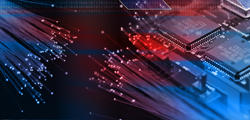Going at Light Speed—Optical Communications and Computing
Challenge

As demand on the U.S. communications network continues to grow, a new generation of transmission and networking technologies is required to keep pace. Keeping pace is critical because communications fundamentally drives productivity gains and economic growth; it cradles innovation in many current and future industries, including telemedicine, entertainment, and security.
To meet these needs, data rates will approach 100 gigabits per second and beyond, but measurements at these bandwidths are lacking. Improvements to the network are required to provide the capacity needed for universal broadband access in our nation.
Networks will have to become more agile, so that operators can better utilize capacity and address changing demands. Currently, few measurement tools exist to monitor the real-time performance of transmission links, making it slow and costly to re-route, or reconfigure, data traffic in a network.
Industry currently lacks the optical measurement capabilities essential to take full advantage of the existing U.S. communications infrastructure and enable next-generation data-transmission technologies. These measurement capabilities are crucial for developing faster fiber-optic data rates and more flexible data-transmission systems and for enabling faster communications within the computers that connect to the information highway.
Proposed NIST Program
This initiative will promote advances in light-scale communications ranging from the nanoscopic innards of an individual computer to the continent-spanning scale of the nation's optical communications network. Already the world leader in measurements of high-speed devices and of hybrid optical and electronic devices, NIST will work closely with industry and expand its work to include research and development of:
- new measurement capabilities to accommodate higher-speed, next-generation communications networks;
- measurements that diagnose and locate transmission problems on data networks, and provide the information needed to reconfigure and redirect traffic to match demand; and
- new measurement techniques for analyzing computer circuits that transmit light instead of electricity, enabling the manipulation of light within computer chips, and interconnecting very small electronic and optical devices.
Expected Impacts
NIST work in this area should help to:
- maintain and increase the competitiveness of U.S. communications and information technology industries by providing new capabilities for optical measurements on existing and new infrastructure;
- lower costs for operating and maintaining communications networks by providing improved functionality of optical communications equipment and creating tools for making networks more robust; and
- increase speeds for individual computer users by supporting the development of higher speed, lower-power computers that use light rather than electricity to process information.

